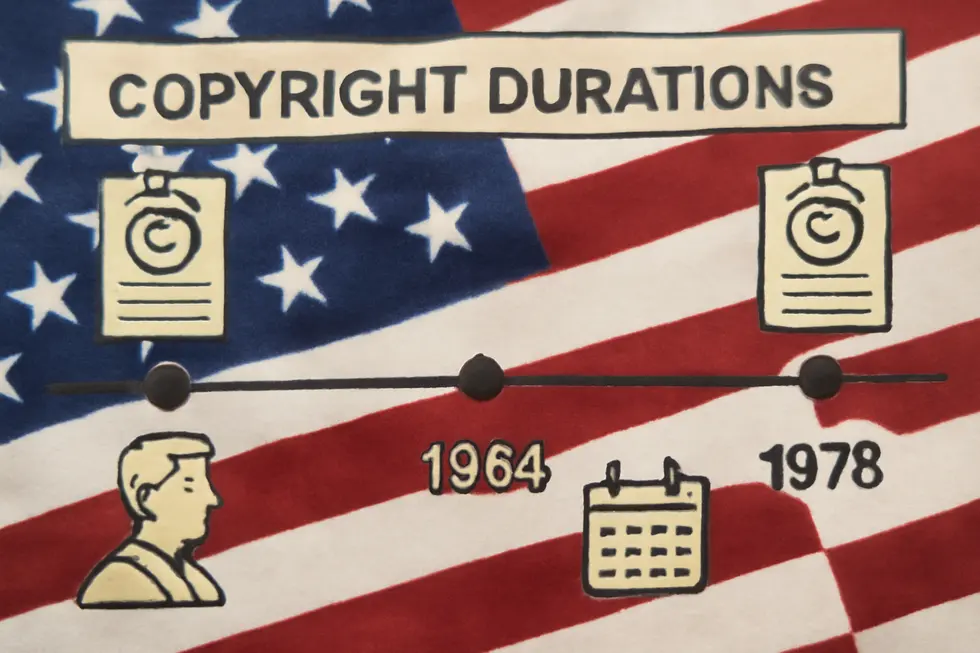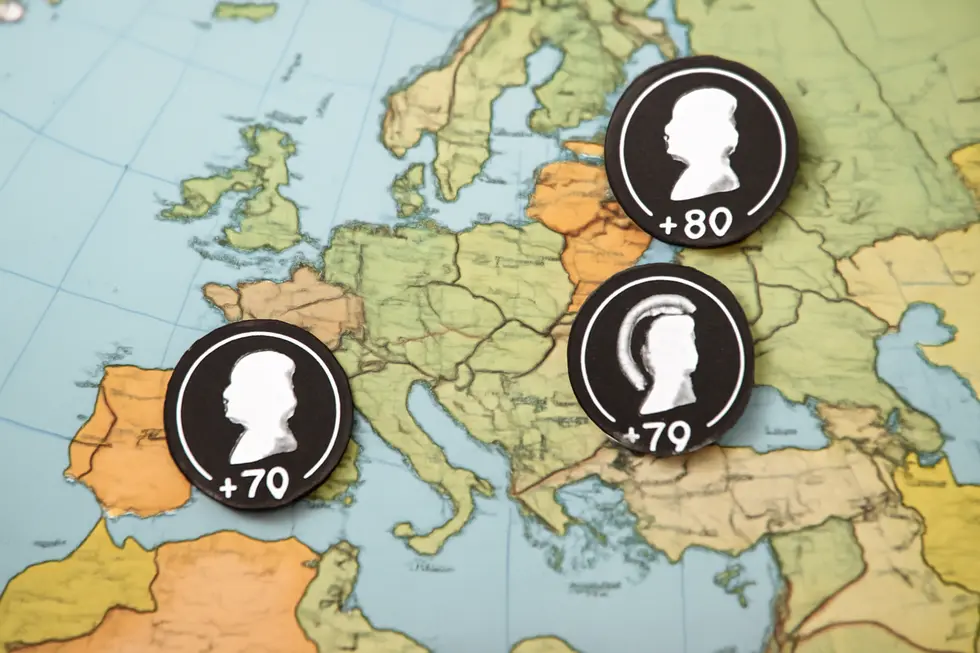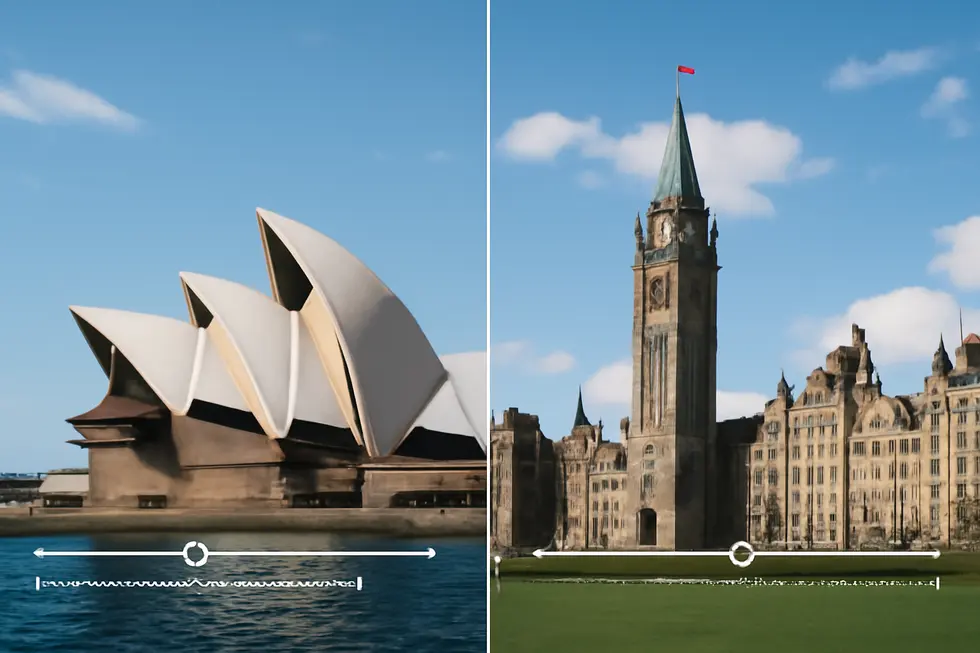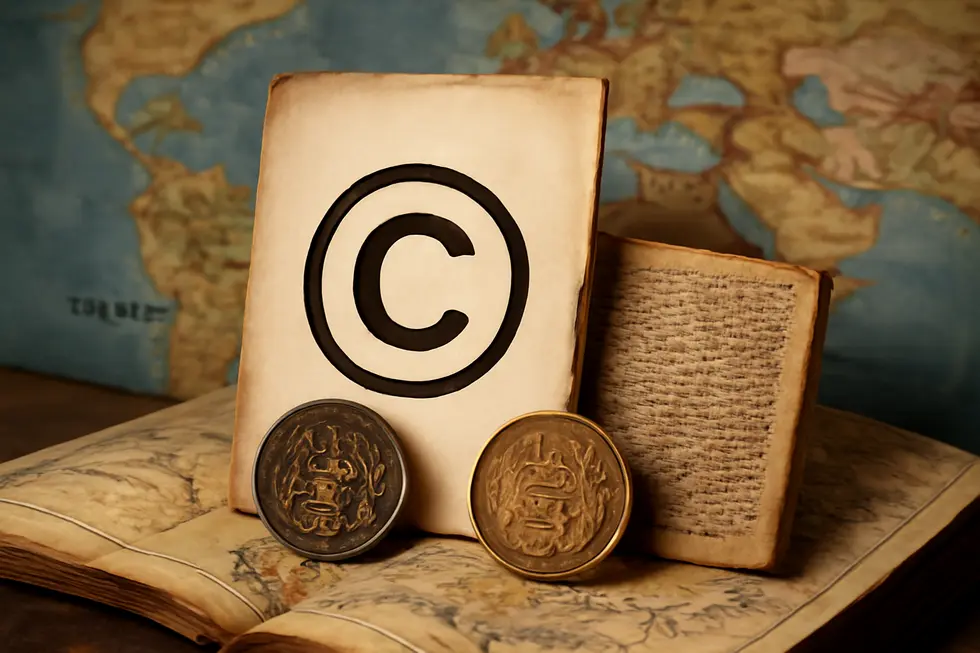Introduction
Understanding the nuances of copyright years is critical for business owners who rely on creative works, whether for branding, media, or product development. Copyright duration determines when a work enters the public domain, affecting the freedom to use, replicate, or adapt content without legal risk. Each region around the world follows different rules—some tied to publication dates, others to the life of the author—making it essential to comprehend these variations to safeguard your business and capitalize on legal use. This guide breaks down the complexities of copyright years in four key areas: the United States’ multifaceted system, European exceptions and standards, copyright terms and extensions in Australia and Canada, and unique global cases involving perpetual copyright. Together, these chapters offer a clear, actionable foundation that will help you navigate copyright durations strategically.
Tables of Contents
Chapter 1: Navigating the Evolution of Copyright Years in the United States
- Tracing Historical Copyright Terms and Renewal Protocols in U.S. Law
- Navigating Modern U.S. Copyright Terms and Notable Exceptions
- Tracing Public Domain Entry in the United States: Key Timelines and Vital Resources for Copyright Status
Chapter 2: Copyright Years in Europe: Variations and Exceptions
- Exploring Europe’s Unique Copyright Terms and Legal Exceptions Beyond the Life Plus 70 Rule
- Perpetual and Unique Copyright Protections Shaping Europe’s Copyright Landscape
- Evolving Harmonization of Copyright Terms in Europe: Balancing Legal Exceptions and Technological Advances
Chapter 3: Copyright Years and Extensions in Australia and Canada
- Tracing the Shift in Copyright Terms: How Australia and Canada Extended Protection Periods and Shaped Access
- Balancing Economic Incentives and Intellectual Property Rights in Australia and Canada’s Copyright Extensions
- Navigating AI, Patent Adaptations, and Societal Challenges in Australian and Canadian Copyright Law
Chapter 4: Special Cases and Perpetual Copyright Years
- Navigating Legal Nuances: Perpetual and Exceptional Copyright Protections
- Navigating Contractual Complexities of Perpetual Copyright in Unique Legal Contexts
- Moral Rights and State-Level Nuances Shaping Special and Perpetual Copyright Cases
Chapter 1: Navigating the Evolution of Copyright Years in the United States

1. Tracing Historical Copyright Terms and Renewal Protocols in U.S. Law
Tracing Historical Copyright Terms and Renewal Protocols in U.S. Law
The history of copyright duration in the United States reflects significant legislative shifts shaped by evolving views on intellectual property rights. Prior to January 1, 1978, U.S. copyright law operated under a paradigm radically different from today’s standards. Initially, per the Copyright Act of 1909, a published work was granted a copyright term of 28 years. This initial term was not permanent; copyright holders had to apply for renewal in the 27th or 28th year to secure an additional 28-year term, totaling up to 56 years of protection. However, later amendments extended these renewal periods by adding up to 47 years, and further prolonged protection with a 20-year extension under the 1998 Copyright Term Extension Act, culminating in a maximum term of 95 years from the date of publication.
Within this historical framework, a critical factor determining whether pre-1964 works remain protected lies in the renewal status. Many works published between 1923 and 1963 slipped into the public domain due to non-renewal. In contrast, works published between 1964 and 1977 automatically benefit from a 95-year term without the burden of renewal, reflecting legislative modernization.
Furthermore, post-1978 law aligned copyright duration closely with the lifespan of the author, offering protection for the life of the author plus 70 years for most works. Works made anonymously or created as works for hire follow a fixed term of either 95 years from publication or 120 years from creation, emphasizing the institution’s recognition of different authorship scenarios.
This evolving system balances creators’ incentives with public access, illustrating how renewal requirements historically shaped the U.S. copyright landscape. For those researching historical works, verifying renewal records remains essential. Resources such as the U.S. Copyright Office and dedicated databases facilitate this process, ensuring accurate determination of copyright status. For additional guidance on copyright terms for businesses and creators, visit copyright law and public domain.
2. Navigating Modern U.S. Copyright Terms and Notable Exceptions
Navigating Modern U.S. Copyright Terms and Notable Exceptions
In the United States, copyright duration has evolved to balance creator rights with public access. For works created by individual authors, copyright now lasts for the life of the author plus 70 years. When multiple authors are involved, protection extends 70 years beyond the death of the last surviving author. However, special rules apply to works made for hire, as well as anonymous and pseudonymous creations. These enjoy protection for either 95 years from publication or 120 years from creation—whichever expires first.
While modern copyrights emphasize longevity, historical terms still impact many works today. Publications released before 1925 are fully in the public domain, allowing unrestricted use. Between 1925 and 1963, copyrights originally lasted 28 years, requiring timely renewal to extend to 95 years total. Failure to renew meant the work surrendered protection and entered the public domain. Renewal status can be verified through accessible resources like the U.S. Copyright Catalog and the Catalog of Copyright Entries.
Sound recordings mirror these timelines, with pieces published in 1924 becoming public domain as of 2025. Updates happen annually on January 1, when works published 95 years prior officially enter the public domain, including many notable compositions and characters.
Some exceptional works, such as certain unpublished materials or government creations, may have extended or indefinite protection due to special legislation, though these cases are uncommon. It’s important to recognize that copyright requires originality and independent creation, with only a minimal threshold of creativity needed.
For creators and users alike, understanding these durations—and verifying renewal or expiration—is essential for lawful use and distribution. Detailed guidance and records are available, helping navigate this complex framework while supporting an informed approach to intellectual property. For further clarity, see the copyright duration overview by the University of Michigan.
3. Tracing Public Domain Entry in the United States: Key Timelines and Vital Resources for Copyright Status
The United States copyright system presents a layered framework for determining when works enter the public domain, primarily hinged on their year of publication and renewal status. As of January 1, 2025, all works published in 1929 or earlier have transitioned into the public domain, reflecting the completion of the 95-year protection term for works published before 1978. This milestone marks a significant expansion of freely accessible cultural and intellectual materials.
Understanding this timeline entails recognizing several pivotal distinctions. All works published prior to 1923 are unequivocally public domain, freely available for use without restriction. For works published between 1923 and 1963, renewal plays a critical role: an initial protection of 28 years required active renewal during the 27th or 28th year to prolong copyright. Failure to renew means these works passed into the public domain. Those renewed remain under copyright for a total of 95 years from their original publication.
Between 1964 and 1977, renewal was eliminated; these works enjoy an automatic 95-year term. Since March 1989, formalities such as registration and renewal have generally been obsolete, simplifying copyright duration to life of the author plus 70 years for individual creators or 95 years from publication for corporate works. Federal government works, conversely, are mostly public domain upon creation, with particular exceptions for outsourced projects.
For researchers and rights holders, resources like the U.S. Copyright Catalog, Stanford’s Copyright Renewal Database, and the Catalog of Copyright Entries are indispensable. These databases provide records necessary to verify copyright status, especially in the critical 1923–1963 window.
Though public domain works are free to use, users should remain aware of potential usage restrictions imposed by some repositories or related laws beyond copyright. For comprehensive guidance on copyright terms and public domain determination, the Oregon State University guide remains an authoritative reference.
Explore further insights about copyright and public domain at copyright law and public domain.
More about public domain status and resources can be found here: https://guides.library.oregonstate.edu/copyright/publicdomain
Chapter 2: Copyright Years in Europe: Variations and Exceptions

1. Exploring Europe’s Unique Copyright Terms and Legal Exceptions Beyond the Life Plus 70 Rule
Across Europe, the standard copyright term is generally set at the life of the author plus 70 years, aligned with the Berne Convention and reinforced by EU directives. However, several countries diverge from this baseline, reflecting distinct legislative decisions and historical circumstances. For instance, Spain extends copyright protection to life plus 80 years for authors who died before 1987, notably surpassing the common EU term. Conversely, Belarus applies a shorter term of life plus 50 years, an outlier compared to most European states. These national variations impact when works enter the public domain and the scope of copyright enforcement.
Beyond the duration of copyright, legal exceptions such as the freedom of panorama differ significantly across countries. This exception permits the public use of images depicting public spaces and artworks without infringing copyright. Notably, Greece and Italy do not recognize freedom of panorama, restricting the ability to freely reproduce photographs or videos of public monuments and sculptures. On the other hand, countries like Hungary and Ireland allow such uses under certain conditions, easing restrictions for creators and users alike.
These variations underscore that while life plus 70 years serves as a common framework, copyright terms and exceptions are not uniform across Europe. Rights holders and users must be vigilant in understanding specific national laws, as these affect both the duration and permissible uses of copyrighted works. For deeper insight into these differences and their implications, see the detailed discussions on copyright in Europe provided by reputable sources like Trademark2Go and Wikipedia’s coverage of freedom of panorama.
2. Perpetual and Unique Copyright Protections Shaping Europe’s Copyright Landscape
In Europe, the standard copyright duration typically lasts for 70 years after the author’s death. However, this broad rule is nuanced by historical statutes and special cases that grant perpetual or unique rights, shaping the copyright landscape in meaningful ways. The United Kingdom exemplifies such exceptions, where the Copyright Act 1775 established permanent copyrights for universities and colleges. These institutions hold copyrights in perpetuity for works bequeathed or donated expressly for educational purposes. Although the Copyright, Designs and Patents Act 1988 abolished most perpetual copyrights, transitional provisions preserve certain rights until 2039. A particularly notable case is Great Ormond Street Hospital’s ongoing right to royalties from J.M. Barrie’s Peter Pan, secured by a special legislative provision despite the underlying work now being out of copyright.
Elsewhere in Europe, countries like Denmark maintain special considerations alongside the general life-plus-70-years term. For example, Denmark’s Consolidated Act No. 1144 of 2014 specifies standard terms for authors but enforces special rules for anonymous works, cinematographic, and musical creations. Furthermore, some governmental or official works receive indefinite protection; Danish government maps produced from 1814 onward illustrate one such rare instance of perpetual copyright.
Beyond Western Europe, historical complexities arise from legacy legal frameworks of the former Soviet Union. Copyrights held by legal entities often continued perpetually, transferring to successors or the state when those entities ceased to exist. These enduring rights contrast sharply with the typical fixed-term copyright model.
These unique exceptions highlight how Europe’s copyright system blends the customary life-plus-70-years rule with exceptional protections that reflect historic, institutional, or governmental interests. Understanding these variations is essential for grasping the real scope of copyright years across Europe.
For deeper insights into the nuances of copyright durations and their impacts, refer to detailed discussions on copyright law and the public domain and consult authoritative legal resources such as the Wikipedia article on perpetual copyright.
3. Evolving Harmonization of Copyright Terms in Europe: Balancing Legal Exceptions and Technological Advances
Europe’s journey toward harmonized copyright years reflects a complex interplay between regional directives and national legal traditions. While the European Union has aimed to standardize copyright duration largely around the life of the author plus 70 years, notable exceptions persist across member states. Countries like Belarus maintain shorter terms (life plus 50 years), and Spain applies extended terms up to life plus 80 years for certain legacy works. This patchwork emerges partly from differing historical practices and the careful balancing of cultural, economic, and legal priorities.
Beyond the duration itself, harmonization confronts rising challenges with legal exceptions, especially regarding emerging technologies. The 2019 Directive on Copyright in the Digital Single Market introduced important rules on text and data mining (TDM), enabling specific uses of copyrighted works for scientific purposes without authorization. However, the practical implementation of these exceptions varies considerably, as national legislatures interpret and transpose directives unevenly. This divergence has led to enforcement gaps and legal uncertainty, hindering pan-European consistency.
A central tension lies in accommodating innovations, such as artificial intelligence training, which require access to vast digital datasets that often include copyrighted materials. EU frameworks acknowledge this need by allowing some exceptions, but they also recognize the rights of authors and publishers, creating a delicate balance. Furthermore, some countries resist full alignment to preserve cultural sovereignty or address local concerns about authors’ rights.
Ongoing research and policy development focus on crafting adaptable harmonization models that respect national diversity while promoting legal certainty. Addressing enforcement inconsistencies and clarifying AI-related exceptions will be critical for ensuring that copyright laws remain relevant and functional in today’s digital environment. For readers interested in a broader context of copyright transitioning to the public domain, further insights are available on copyright law and public domain.
For deeper understanding of the EU Copyright Directive’s influence on emerging exceptions, refer to official analyses of international copyright law alignment.
Chapter 3: Copyright Years and Extensions in Australia and Canada

1. Tracing the Shift in Copyright Terms: How Australia and Canada Extended Protection Periods and Shaped Access
The evolution of copyright durations in Australia and Canada reflects a broader international trend toward harmonizing protection periods while balancing public access. Both countries extended their standard copyright term from life of the author plus 50 years to life plus 70 years, aligning more closely with the United States and European Union frameworks. However, these extensions were carefully calibrated and notably non-retroactive.
In Australia, legislative changes enacted in 2004 lengthened copyright duration to life plus 70 years. This extension applied only to authors who died in 1955 or later; works of earlier authors had already passed into the public domain and remained there. This has meant a frozen period where no new Australian authors entered the public domain between 2005 and January 1, 2026, when works of authors who died in 1955 become newly available. Additionally, Australia’s copyright reforms expanded fair dealing exceptions, recognizing modern needs such as parody and satire.
Canada’s shift occurred even more recently, with the Copyright Act amendment effective December 30, 2022. The term also extended to life plus 70 years, but like Australia, it did not revive expired copyrights. Only authors who died after 1972 benefit, meaning no new Canadian authors enter the public domain before January 1, 2043. Canada paralleled Australia’s expansion in fair dealing, particularly enhancing rights for education and parody through legislative updates in the 2010s.
These extensions reflect efforts to harmonize protections with major trading partners and international agreements, though they contrast with some European countries where retroactive restorations occurred. Both countries’ laws also continue to apply separate rules for government works. The legal foundations trace back to British imperial statutes such as the 1911 UK Copyright Act, which initially unified copyright standards but evolved distinctly in each nation.
While the longer terms delay public domain access, updated exceptions help preserve user rights for cultural and educational engagement. This dynamic balance between economic control and public interest continues to shape how copyright years influence access in Australia and Canada.
For more on copyright terms and public domain status, see the overview on copyright law and public domain.
Further historical context is available through the UK Copyright Act of 1911.
2. Balancing Economic Incentives and Intellectual Property Rights in Australia and Canada’s Copyright Extensions
Australia and Canada both adopt a copyright term of the author’s life plus 70 years, aligning with international standards like the Berne Convention. This extended duration aims to reward creators and their heirs by providing long-term economic control over their works, allowing sustained revenue through reproduction, distribution, and adaptation rights. These protections help safeguard creative assets from premature public access or corporate takeover, preserving cultural and economic value within rights holders’ domains.
However, prolonged copyright terms also impact broader economic and cultural dynamics. By delaying when works enter the public domain, these extensions restrict the ability of others to freely build upon existing ideas, potentially hindering innovation and the dissemination of knowledge. Both nations recognize this tension, implementing fair dealing provisions that permit limited uses—such as research, criticism, or parody—without permission. These exceptions balance protecting creators’ rights while ensuring society benefits from access to creative content.
In Australia, the copyright landscape continues to evolve amid debates on modernizing intellectual property laws, particularly to accommodate technological advances like text and data mining. Such reforms seek to boost productivity and innovation without undermining the economic incentives copyright offers. Australia also has unique provisions involving Crown copyright, allowing some government works to be used under specific conditions without infringement—an aspect less prominent in Canadian law.
Meanwhile, Canada actively engages in international policy discussions to refine IP frameworks, signaling ongoing efforts to harmonize protections and optimize economic outcomes tied to intellectual property. Both countries thus strive to strike a nuanced equilibrium between fostering creativity through extended protection and encouraging public access through well-defined exceptions and eventual public domain entry.
For additional insight on how copyright supports business and creativity, explore our copyright definition for business owners. Further details on Australia’s reform proposals can be found via IP Australia’s official resources.
3. Navigating AI, Patent Adaptations, and Societal Challenges in Australian and Canadian Copyright Law
Australia and Canada are at the forefront of adapting copyright laws to address rapid technological advances, especially in artificial intelligence (AI), while considering societal and economic impacts. In Australia, the 2025 Productivity Commission report emphasizes updating copyright frameworks to better support AI innovation. Notably, proposals include introducing a text and data mining exception, enabling lawful access to copyrighted materials for AI training. This reform aims to balance the rights of creators with the economic boost AI is expected to generate—estimated at AUD 116 billion over the next decade by enhancing productivity and innovation.
Canada’s copyright system, built around fair dealing exceptions for research, education, and parody, faces ongoing scrutiny amid evolving digital technologies. Canadian policymakers continue to weigh how to balance open access with protecting rights holders amid AI’s growing influence. These discussions align with broader international copyright negotiations and debates around open-access publishing, reflecting societal concerns about equitable knowledge dissemination versus publisher protections.
Patent terms in both countries are also adapting, influenced by international practices such as U.S. Patent Term Adjustments that compensate for regulatory delays, especially in pharmaceuticals. Australia and Canada maintain patent term extensions—typically capped at five years—to strike a balance between incentivizing innovation and ensuring eventual public access.
Ethical and social challenges surrounding AI add further complexity. Australia calls for clearer regulations to mitigate AI-related risks like bias and unfair market dynamics. Similarly, Canada investigates issues like digital platform competition and algorithmic pricing, impacting AI governance.
Together, Australia’s proactive reform approach and Canada’s cautious evolution reflect a shared priority: developing legal frameworks that foster innovation while addressing ethical and societal concerns. For additional context on copyright’s economic and business relevance, see this resource on copyright definition and economics.
Further reading on these developments can be found in the Australian Productivity Commission’s 2025 report on copyright and AI reforms.
Chapter 4: Special Cases and Perpetual Copyright Years

1. Navigating Legal Nuances: Perpetual and Exceptional Copyright Protections
Navigating Legal Nuances: Perpetual and Exceptional Copyright Protections
While copyright law typically grants protection for a limited time—often the life of the author plus 70 years—there are notable exceptions creating perpetual or indefinite copyrights. These exceptions commonly apply to works created or owned by governments, unpublished works, or uniquely classified materials, whose protection often extends beyond conventional terms due to special legislative provisions.
Globally, the standard copyright duration is anchored to the author’s lifespan plus a fixed period. However, certain jurisdictions enact enduring protections: Cuba, for instance, grants perpetual copyright to government works, and Denmark enforces indefinite copyright over specific official maps through 19th-century royal decrees. Ireland protects the designs of banknotes and coins indefinitely, recognizing their intrinsic state significance. Similarly, Singapore extends perpetual copyright to unpublished governmental literary and musical works until their first public release, after which they transition to normal copyright durations.
Beyond economic rights, many countries safeguard moral rights without time limits. These rights preserve the personal and reputational connection of the author to their work, surviving the expiration of economic copyrights and underscoring deeply rooted legal philosophies about authorship.
Copyright also distinguishes between derivative and joint works. Protection applies only to new original elements added by a derivative work’s creator, not the underlying content itself. Joint works require intentional collaboration to merge contributions inseparably.
In the United States, complexities arise notably for works published before 1964. These works initially enjoy 28 years of protection, but a timely renewal extends copyright to 95 years from publication; otherwise, they enter the public domain. This renewal requirement and its implications illustrate the importance of verifying copyright status in older works.
These legal nuances emphasize the critical need for careful research and understanding, especially in special cases involving perpetual copyrights linked to government or unique materials. For more insights on perpetual protections related to government works, see Trademark2Go’s detailed analysis.
For U.S. specifics on copyright terms and the complexities of renewal, refer to the Wikimedia Commons Licensing guidelines.
2. Navigating Contractual Complexities of Perpetual Copyright in Unique Legal Contexts
Perpetual copyright assignments embedded in legacy contracts introduce complex legal dynamics that extend far beyond typical copyright durations. Courts have frequently upheld agreements that use unequivocal language granting rights “in perpetuity,” confirming such contracts remain enforceable despite technological advances. For instance, India’s Bombay High Court affirmed that broad terms like “by any and every means whatsoever” demonstrate clear intent to confer perpetual exploitation rights, especially when royalty payments persist, ensuring assignees benefit indefinitely from continued monetization. This creates a distinct contractual landscape where rights and royalties endure beyond conventional timelines.
However, these perpetual obligations are not without limitations. Many courts emphasize that royalty payments and other ongoing contractual duties are implicitly tethered to the underlying copyright term. In Thomson v. Hodgson, the argument prevailed that once copyright expires and works pass into the public domain, contractual royalties logically cease. This underscores an important boundary where perpetual contract language may yield to statutory copyright expiration unless a special exception applies.
Several jurisdictions recognize statutory exceptions granting truly indefinite or perpetual copyright on certain works. Government publications in Cuba, official maps in Denmark, and protected monetary designs in Ireland exemplify this rare status, which significantly impacts how contracts structure licensing and enforcement. Likewise, moral rights, which often survive economic rights, may impose perpetual obligations related to author attribution and integrity. This enduring protection demands nuanced contractual language to clarify rights duration and scope.
International variation further complicates matters. Contracts spanning multiple territories must address these disparate laws, specifying governing jurisdictions and dispute resolution to mitigate legal uncertainty. The tension between perpetual rights and public policy also arises, as indefinite control over works can hinder public access and cultural growth.
For a deeper understanding of how contracts navigate these enduring rights in evolving legal environments, see the detailed analysis on the validity of pre-digital-era copyright assignments here and explore more about contractual copyright language for business owners here.
3. Moral Rights and State-Level Nuances Shaping Special and Perpetual Copyright Cases
Moral rights serve to protect creators’ personal and reputational interests independently from economic rights such as copying or distribution. These rights predominantly encompass the right of attribution—which grants authors recognition as the creators—and the right of integrity, protecting works from distortion or alteration that might harm an artist’s honor. Globally, these protections are anchored in Article 6bis of the Berne Convention, reflecting a universal respect for the personal connection between creator and creation.
In the United States, however, moral rights have a very limited footprint. The Visual Artists Rights Act (VARA) of 1990 narrowly applies moral rights protections to specific visual art categories such as paintings, drawings, prints, sculptures, and certain photographs intended for exhibition. Importantly, these rights can be contractually waived, and extend neither to literary, musical, nor broader categories of creative works. This limited federal recognition leaves a patchwork of protections that vary widely by state.
At the state level, protections tied to moral rights and artists’ reputations are uneven and generally curtailed by federal preemption. Some states offer additional safeguards related to rights of publicity or reputation, but these rarely codify broad moral rights or unify protection across artistic categories. This layered landscape means creators often rely primarily on federal protections or specific contractual agreements rather than comprehensive moral rights safeguards.
When considering copyright duration within these special and perpetual cases, it’s critical to recognize that no current U.S. or international law allows for perpetual copyright. Instead, copyrights remain time-limited—typically the life of the author plus 60 to 70 years, varying by jurisdiction and type of work. Special classifications, such as anonymous or works made for hire, have term calculations based on publication or creation dates but still conclude within finite timeframes. This framework ensures a balance between creators’ rights and eventual public access.
For a deeper understanding of copyright duration and its justifications, consult the comprehensive guidance available from Trademark2Go about copyright duration norms.
Final thoughts
An in-depth understanding of copyright years across major regions equips business owners to make informed decisions about using creative works, protecting intellectual property, and respecting legal boundaries. The United States’ layered rules demand attention to renewal records and publication dates, while Europe’s mostly consistent life-plus-70 standard includes notable exceptions that affect rights duration. Australia and Canada’s extensions introduce retroactive complexities that require vigilance when dealing with works by authors who died decades ago. Lastly, special cases like perpetual copyright for government or specific works highlight exceptional scenarios where copyright protection endures indefinitely. By mastering these nuances, businesses can confidently navigate copyright constraints, avoid costly infringement, and leverage public domain opportunities to sustain innovation and growth.
Your IP is the foundation of your success – let’s protect it together before it’s too late. We can’t wait to help you turn your ideas into legally secured assets.
About us
undefined


